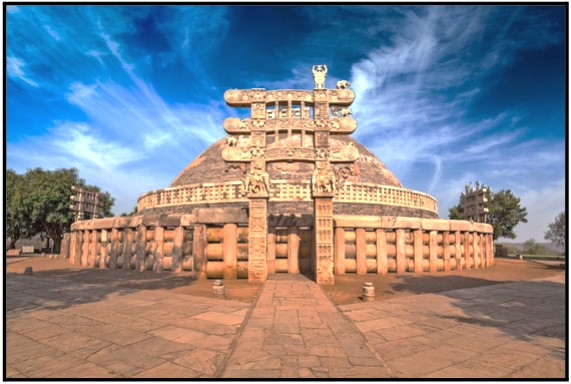GS-I
Introduction:
Early Indian sculptures adorned the entrances of the Great Stupa at Sanchi, Madhya Pradesh, during the 1st century BC.
This stupa is renowned as one of the most magnificent monuments of its era. From the 3rd century BC to the 11th century AD, the region of Sanchi, along with other significant centers like Sarnath and Mathura, experienced a continuous artistic development, showcasing a rich and enduring artistic history.
Sanchi Stupa:

- The Sanchi Stupa is a significant Buddhist landmark in India, housing some of the country's earliest stone buildings.
- It stands as one of India's oldest stone constructions and a crucial monument in Indian architecture.
- Commissioned by Mauryan ruler Ashoka the Great in the third century BCE, the stupa initially consisted of a basic hemispheric brick edifice constructed to enshrine Buddha's relics.
- Located in Sanchi, a historic city nestled in the Vindhya Range about 45 kilometers from Bhopal, Madhya Pradesh, the site encompasses 50 additional structures, including temples and monasteries.
- The intricate carvings and inscriptions found here depict Indian architecture from the Mauryan era (3rd century BCE) to the later medieval period (around the 11th century CE).
- Notable features of the Sanchi complex include the Mahastupa, the Ashokan pillar adorned with inscriptions, and the exquisite torans (gateways).
- Designated as a UNESCO World Heritage Site since 1989, Sanchi Stupa is hailed as possibly India's best-preserved Buddhist monument complex.
- It serves as a testament to the rich cultural heritage of Madhya Pradesh and holds immense historical and architectural significance.
Historical Background:
- Sanchi's monuments comprise a collection of Buddhist structures dating back to the Mauryan Empire (3rd century BCE) and continuing through the Gupta Empire (5th century CE) until around the 12th century CE.
- The Great Stupa, also known as Stupa No. 1, is the oldest and most significant monument among them.
- Originally created under the Mauryans, the Great Stupa is adorned with one of Ashoka's Pillars.
- Over the centuries, particularly during the rule of the Shungas and Satavahanas, the Great Stupa underwent enlargement and embellishment with gates and railings. Additionally, smaller stupas like Stupa No. 2 and Stupa No. 3 were constructed nearby.
- According to the Ashokavadana, the stupa suffered vandalism around the 2nd century BCE, which some attribute to the ascension of Shunga monarch Pushyamitra Shunga, who overthrew the Mauryan Empire.
- Legend suggests that the original stupa was demolished by Pushyamitra, with his son Agnimitra reconstructing it.
- During the Shunga period, the original brick stupa was encased in stone.
- British captain Edward Fell provided one of the earliest accounts of the Sanchi Stupa in 1819.
- However, it wasn't until 93 years later that John Marshall "rediscovered" the site, leading to its restoration over the following seven years to its present state.
Features of Sanchi Stupa:
- The Sanchi complex boasts several remarkable features, including the Mahastupa (Great Stupa), the Ashokan pillar adorned with inscriptions, and the beautiful torans (gateways).
- The torans and fencing draw inspiration from the bamboo crafts of the surrounding regions, showcasing intricate designs reminiscent of bamboo craft and knotted bamboo.
- Originally constructed using bricks, the stupa was later covered with stone, vedica, and torana (gateway), enhancing its grandeur.
- With four entrances, the southern entrance was the first to be completed, followed by the addition of others over time.
- The gateways are intricately carved and adorned with statues, featuring depictions of shalabhanjika, symbolic of women grasping a tree branch, along with stories from the Jataka tales.
- Encircling the structure is a lower and upper circumambulatory walkway known as the pradakshina patha, with the upper path being a distinctive feature of this stupa.
- Situated on the southern side of the stupa is the Ashokan Lion Capital pillar, bearing inscriptions.
- The Anda refers to the hemispheric dome of the stupa, housing the Buddha's relics, while atop it lies the harmika, a square railing, and the chhatra, an umbrella symbolizing protection.
- Additionally, a sandstone pillar inscribed with Ashoka's Schism Edict can be found at the site.
- During the Shunga dynasty's rule, the original brick dome underwent expansion, doubling in size and being covered with stone slabs.

Connection with Buddhism:
Surprisingly, there is no historical evidence of Buddha ever visiting Sanchi, and even renowned travelers like Hiuen Tsang did not mention it in their accounts of Buddhist sites in India. Marshall's analysis in "The Monuments of Sanchi" reveals that Sanchi did not receive the same level of reverence as other Buddhist pilgrimage sites. Scholars like Alfred A. Foucher suggest that the iconic Buddha images at Sanchi, such as the Bodhi tree and an empty throne, are influenced by interactions between Graeco-Buddhist architectural styles.
Conclusion:
Despite its lack of direct association with Buddha, Sanchi Stupa's significance goes beyond its religious ties. It has left a lasting impact on modern architecture, notably influencing structures like the Rashtrapati Bhavan. Lord Charles Hardinge's directive to architect Edwin Lutyens resulted in the incorporation of Sanchi-style elements, such as the dome and balustrade railing, into the Rashtrapati Bhavan's design. Additionally, the dome of Kolkata's Birla Planetarium, inspired by Sanchi's dome, further highlights the enduring legacy of Sanchi's architectural influence

